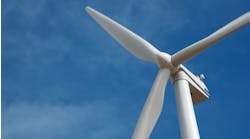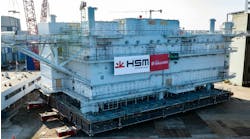Trump temporarily halts leasing and permitting for wind energy projects
Related content:
Trump declares national energy emergency
President Donald Trump orders US to withdraw from Paris climate agreement.
By Bruce Beaubouef, Managing Editor
President Donald Trump signed an executive order on Monday temporarily halting offshore wind lease sales in federal waters and pausing the issuance of approvals, permits and loans for both onshore and offshore wind projects.
As reported by the Associated Press, the Secretary of Interior will now review wind leasing and permitting practices for federal waters and lands. The assessment will consider the environmental impact of wind projects on wildlife, the economic costs associated with the intermittent generation of electricity, and the effect of subsidies on the viability of the wind industry.
Trump’s pick for Interior Secretary, Doug Burgum, was asked during his confirmation hearing whether he would commit to continuing with offshore wind leases that have been issued. Burgum said that projects “that make sense” and have already been approved will continue to be developed.
Wind power currently provides about 10% of the electricity generated in the United States, making it the nation’s largest source of renewable energy. There is 73 gigawatts of offshore wind capacity under development in the US, according to the American Clean Power Association.
Following the election, Trump tasked New Jersey congressman Jeff Van Drew – a vocal critic of offshore wind – with drafting an executive order on offshore wind he could issue early in his term. Van Drew said he quickly sent the draft to Burgum. Van Drew has said that he views the executive order as a first step toward an eventual moratorium on offshore wind development.
But analysts have noted that by including onshore wind projects too, Monday’s order is far broader than what Van Drew had proposed.
Offshore wind is among the sources of new power generation that will cost the most, at about $100 per megawatt hour for new projects connecting to the grid in 2028, according to estimates from the Energy Information Administration. That includes tax credits under the Inflation Reduction Act, which reduces the cost of renewable technologies. But onshore wind is one of the cheapest sources, at about $31 on average for new projects, according to the EIA data.
New natural gas-based power plants are expected to produce electricity at nearly $43 per megawatt hour, according to the estimates, but with greater reliability, the EIA noted.
The Biden administration had sought to ramp up offshore wind development, approving nearly a dozen commercial-scale offshore wind energy projects. Biden’s goal of 30 gigawatts (GW) of offshore wind by 2030 had prompted many European project developers to acquire leases and plan wind farms in the United States.
As reported by Reuters, a list of the European companies involved in the US offshore wind market includes:
- BP – The British oil major has a lease off the coast of Massachusetts to build the Beacon Wind project that would become part of its newly announced offshore wind joint venture with Japan’s Jera.
- EDF – France’s state-owned EDF and oil major Shell have a 50-50 joint venture, Atlantic Shores, which has approval to build two projects off the coast of New Jersey.
- EDPR – Portugal’s EDPR has a 50-50 offshore wind joint venture with Engie called Ocean Winds, which is developing the Southcoast Wind project off the coast of Massachusetts. It is scheduled to begin construction in late 2025.
- Engie – The French company’s Ocean Winds joint venture with EDPR is also developing the Bluepoint Wind project off the coast of New York and New Jersey; and the Golden State Wind project off California’s central coast.
- Equinor – Norway’s Equinor is developing the Empire Wind project that is expected to become operational in 2027. It could be followed by a second Empire Wind project. Equinor has also won leases to build projects off the coast of Delaware and a lease off the coast of California.
- Iberdrola – The Spanish company’s US subsidiary Avangrid has a 50-50 joint venture with Copenhagen Infrastructure Partners to construct Vineyard Wind 1 off the coast of Massachusetts. It is also developing Kitty Hawk Wind off the coasts of Virginia and North Carolina, and New England Wind 1 and 2 off the coast of Massachusetts.
- Orsted – Denmark’s Orsted owns Block Island, the first operational offshore wind farm in the US off Rhode Island. It is also developing several more projects off the East coast including Sunrise Wind. Orsted on Monday said the commissioning of Sunrise Wind had been delayed to 2027 and made public a 12.1 billion Danish crowns ($1.68 billion) impairment relating to higher costs and delays.
- RWE – Germany’s RWE and Britain’s National Grid have partnered to develop offshore wind projects in the Northeast US with a lease off the coast of New York and New Jersey. RWE also has a lease to develop a floating wind farm off the coast of California.
- Shell – The oil major has a joint venture with France’s EDF to build two projects off the coast of New Jersey called Atlantic Shores.
- TotalEnergies – France’s TotalEnergies holds two maritime leases in the New York Bight and North Carolina’s Long Bay. The Long Bay project will be over 1 Gigawatt with startup scheduled for 2030. The project offshore New York and New Jersey is held through the Attentive Energy joint venture.
Editor's note: This story is an update to Trump expected to order ‘pause’ on offshore wind lease sales | Offshore.
Check out coverage from our other Endeavor Business Media brands:
President Donald Trump propels pro-fossil fuel, oil and gas, agenda with day-one executive orders, national energy emergency declaration | Oil & Gas Journal
In his first hours in the White House, President Trump ordered the government to resume processing LNG export permits, reversed actions to close parts of Alaska and federal waters to oil and gas development, pumped the brakes on a transition to EVs, and bid adieu to the Paris climate accords.
Trump's auto policies would reduce US production targets | IndustryWeek
Increased tariffs, emissions rollbacks and eliminating incentives will bring turmoil and instability.
Will Trump’s second term usher in golden age for trucking? | Fleet Maintenance
Relaxed regulations and an America first economic policy are a few ways the incoming president can help pull trucking from its current rut.
Maintenance mindset: Manufacturers prepare for impact of new US tariff policy | Plant Services
With a planned 25% tariff on imports from Canada and Mexico, and potential wider implementation of a 'universal tariff,' manufacturers are preparing for significant operational cost increases and strategic adjustments.
3 ways a second Trump presidency could affect building owners and operators | Buildings
Tariffs, interest rates, and changes in priorities around decarbonization and climate change could impact building owners and facility managers.

Bruce Beaubouef | Managing Editor
Bruce Beaubouef is Managing Editor for Offshore magazine. In that capacity, he plans and oversees content for the magazine; writes features on technologies and trends for the magazine; writes news updates for the website; creates and moderates topical webinars; and creates videos that focus on offshore oil and gas and renewable energies. Beaubouef has been in the oil and gas trade media for 25 years, starting out as Editor of Hart’s Pipeline Digest in 1998. From there, he went on to serve as Associate Editor for Pipe Line and Gas Industry for Gulf Publishing for four years before rejoining Hart Publications as Editor of PipeLine and Gas Technology in 2003. He joined Offshore magazine as Managing Editor in 2010, at that time owned by PennWell Corp. Beaubouef earned his Ph.D. at the University of Houston in 1997, and his dissertation was published in book form by Texas A&M University Press in September 2007 as The Strategic Petroleum Reserve: U.S. Energy Security and Oil Politics, 1975-2005.



